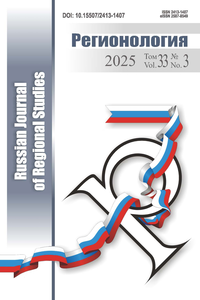A. D. Lisenkova. The Alternative for Germany and the Left Parties in the Eastern States: Transformation of Electoral Preferences
UDК 327.3
doi: 10.15507/2413-1407.124.031.202303.426-441
Introduction. The separate existence of East Germany over the years has led to the formation of unique electoral preferences of citizens. In eastern federal states the Left as the heir to the Socialist Unity Party of Germany remained one of the leaders for a long time. However, in recent years its traditional electorate has increasingly begun to choose the Alternative for Germany. The aim of this article is to identify the main reasons for this shift in preferences in East Germany.
Materials and Methods. The main materials were the results of the elections to the Bundestag and Landtags. The statistics illustrating the performance of the Left on the national average and separately in East Germany in the national elections since 2009 was processed with the help of comparative analysis, the same was done with regard to the subnational elections since 2009 and 2011. The results of the Alternative for Germany were evaluated from its inception in 2013. Additionally, the data was used on preferences among voters of various age groups, the rating of the National Democratic Party of Germany before and after the advent of the Alternative for Germany, as well as GDP per capita indicators.
Results. It is confirmed that it was the Alternative for Germany that mainly occupied the former niche of the Left. The main reasons that comprehensively influenced electoral preferences include the generational change, the unsuccessful adaptation of the left forces to Western values, the unpopularity of anti-capitalist rhetoric, the presence of more influential opponents on key left-wing topics, the demand for conservative and opposition ideology (e.g. in migration policy), as well as the ability of right-wing populists to work with protest voters.
Discussion and Conclusion. The decline in the ratings of the left has become a rather stable phenomenon in recent years, while the performance of the right-wing populists strongly depended on the reaction of the party to a particular political crisis. However, this was more about the general popularity of the Alternative for Germany, which did not imply real prerequisites for the return of the electorate to the Left. The results of this paper can be applied in expert-analytical and research activities aimed at explaining electoral processes.
Keywords: the Alternative for Germany Party, the Left Party, East Germany, federal state, Bundestag, Landtag, elections
Conflict of interests. The author declares that there is no conflict of interest.
For citation: Lisenkova A.D. The Alternative for Germany and the Left Parties in the Eastern States: Transformation of Electoral Preferences. Russian Journal of Regional Studies. 2023;31(3):426–441. https://doi.org/10.15507/2413-1407.124.031.202303.426-441
REFERENCES
1. Giannotti A. Germany and the EU: Motive Power or Hegemonic Risk? World Economy and International Relations. 2022;66(7):24–32. (In Russ., abstract in Eng.) https://doi.org/10.20542/0131-2227-2022-66-7-24-32
2. Belov V.B. 30th Anniversary of the Fall of the Berlin Wall: Features of Germany’s Economic Unification. Scientific and Analytical Herald of the Institute of Europe RAS. 2019;(6):11–17. (In Russ., abstract in Eng.) https://doi.org/10.15211/vestnikieran620191117
3. Shcherbakov V.Yu. Immigration Policy of the German “Left Party – PDS”: Genesis, Evolution and Prospects. Historical, Philosophical, Political and Law Sciences, Culturology and Study of Art. Issues of Theory and Practice. 2016;(11):205–210. (In Russ., abstract in Eng.) EDN: WNDZQP
4. Lisenkova A.D. Main Features of the Modern Environmental Agenda of the Alternative for Germany. Administrative Consulting. 2022;(4):146–158. (In Russ., abstract in Eng.) https://doi.org/10.22394/1726-1139-2022-4-146-158
5. Maksimychev I.F. The Four Power Status of West Berlin. One-Sided German Regulation. Contemporary Europe. 2020;(6):191–201. (In Russ., abstract in Eng.) https://doi.org/10.15211/soveurope62020191201
6. Yerofeyev D. R. The Ideological Origins of the Alternative for Germany (AfG) Party’s Program Settings. International Relations and Dialogue of Cultures. 2020;(8):37–53. Available at: https://internrelat.spbstu.ru/article/2020.8.3/ (accessed 16.02.2023). (In Russ., abstract in Eng.)
7. Rabotyazhev N.V. Alternative for Germany: Between Conservatism and Right-Wing Populism. Politeia. 2022;(3):158–178. (In Russ., abstract in Eng.) https://doi.org/10.30570/2078-5089-2022-106-3-158-178
8. Goerres A., Spies D.C., Kumlin S. The Electoral Supporter Base of the Alternative for Germany. Swiss Political Science Review. 2018;24(3):246–269. https://doi.org/10.1111/spsr.12306
9. Badaeva A.S. Right Turn or the New Alternative for Germany. Analysis and Forecasting. IMEMO Journal. 2019;(2):61–74. (In Russ., abstract in Eng.) https://doi.org/10.20542/afij-2019-2-61-74
10. Pushkareva V.V. A New Political Movement in Germany: Goals and Perspectives. Bulletin of Udmurt University. Sociology. Political Science. International Relations. 2019;3(1):62–72. Available at: https://journals.udsu.ru/sociology/article/view/4023/3894 (accessed 16.02.2023). (In Russ., abstract in Eng.)
11. Rukavitsyn P.M. Germany’s Die Linke: Origin, Ideology and Political Perspective. Vestnik of Moscow State Linguistic University. 2015;(2):145–152. Available at: https://www.vestnik-mslu.ru/Vest/Vest15-713zc.pdf (accessed 16.02.2023). (In Russ., abstract in Eng.)
12. Fernandes S. Ecosocialism from the Margins. NACLA Report on the Americas. 2020;52(2):137–143. https://doi.org/10.1080/10714839.2020.1768731
13. Pogorelskaya S.V. [The 2019 European Parliament Elections]. Evropeiskii soyuz: fakty i kommentarii. 2019;(97):11–15. (In Russ.) https://doi.org/10.15211/eufacts320191115
14. Olsen J. The Left Party and the AfD. German Politics and Society. 2018;36(1):70–83. https://doi.org/10.3167/gps.2018.360104
15. Weisskircher M. The Strength of Far-Right AfD in Eastern Germany: The East-West Divide and the Multiple Causes behind ‘Populism’. The Political Quarterly. 2020;91(3):614–622. https://doi.org/10.1111/1467-923X.12859
16. Moreau P. Aux marges du systdme politique: Die Linke et l’AfD aux elections au Bundestag de 2021. Revue d’Allemagne. 2022;54(1):217–235. (In Franch) https://doi.org/10.4000/allemagne.3090
17. Lisenkova A.D. COVID-19: Influence on the Political Agenda of Alternative for Germany. Contemporary Europe. 2022;(4):200–209. Available at: http://www.sov-europe.ru/2022-4/sovid-19-vliyanie-na-politicheskuyu-povestku-alternativy-dlya-germanii.html (accessed 16.02.2023). (In Russ., abstract in Eng.)
18. Pesthy M., Mader M., Schoen H. Why is the AfD so Successful in Eastern Germany? An Analysis of the Ideational Foundations of the AfD Vote in the 2017 Federal Election. Politische Vierteljahresschrift. 2021;62(1):69–91. https://doi.org/10.1007/s11615-020-00285-9
Submitted 25.01.2023; revised 22.03.2023; accepted 04.04.2023.
About the author:
Alena D. Lisenkova, Postgraduate Student, School of International Relations, Saint-Petersburg State University (7/9 Universitetskaya Emb., St. Petersburg 199034, Russian Federation); Lecturer, Faculty of International Relations and Politics, North-West Institute of Management, Russian Presidential Academy of National Economy and Public Administration (57/43 Sredny prospect VO, St. Petersburg 199178, Russian Federation), ORCID: https://orcid.org/0000-0002-2457-3466, Researcher ID: GRF-1214-2022, Scopus ID: 57878750700, alena.denisovna@yandex.ru
The author has read and approved the final version of the manuscript.

All the materials of the "REGIONOLOGY" journal are available under Creative Commons «Attribution» 4.0
















